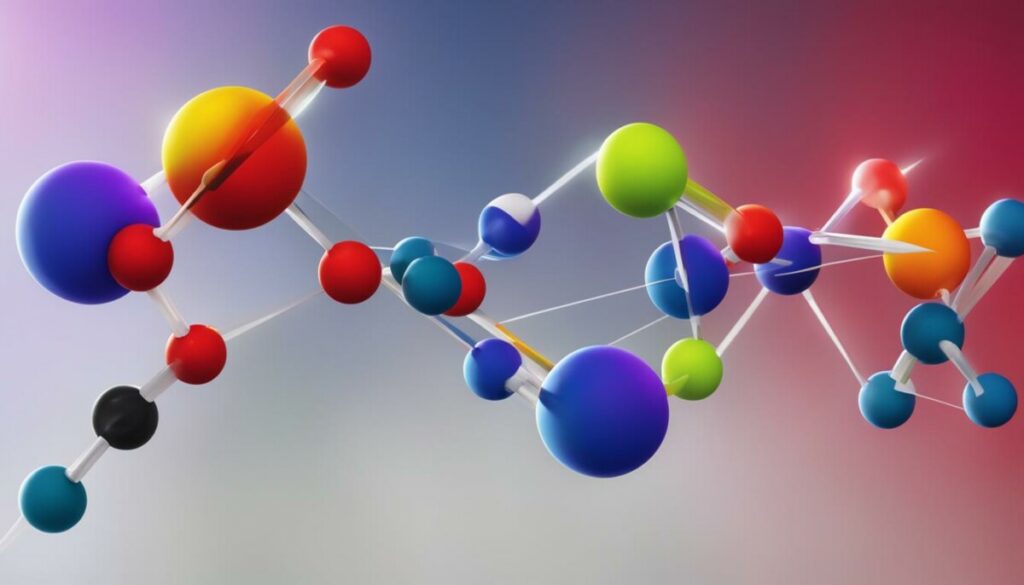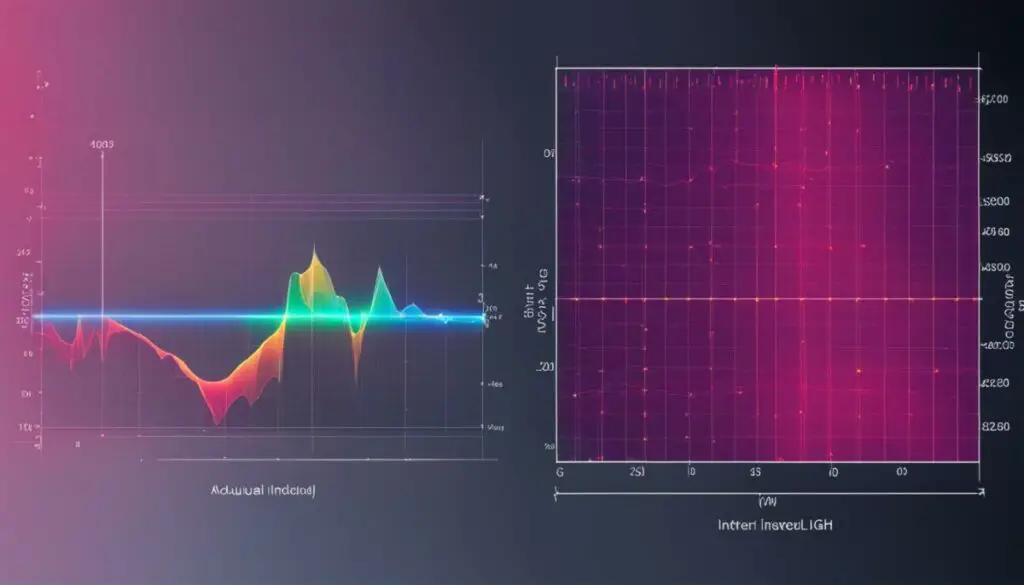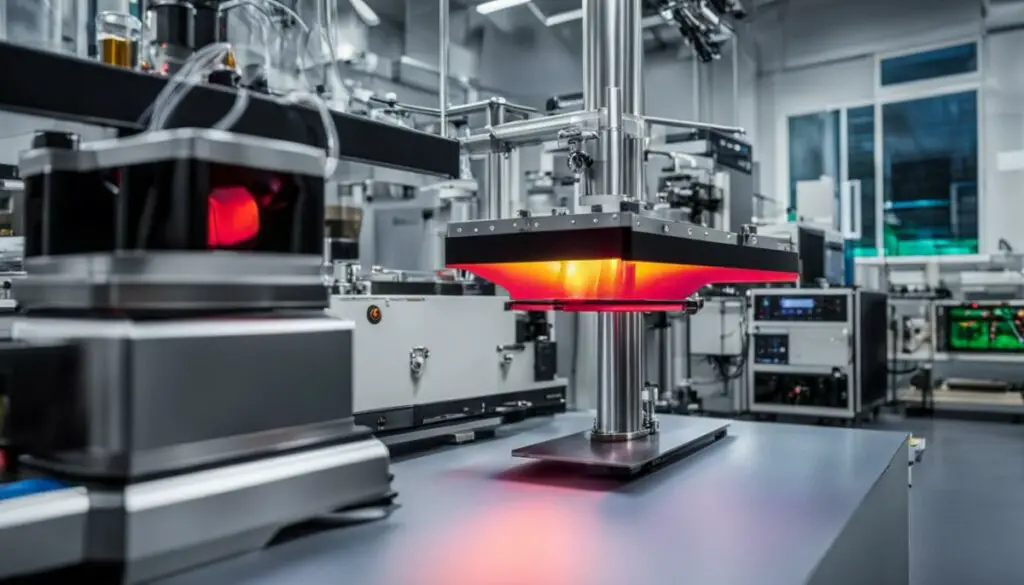Last Updated on 6 months by Francis
Welcome to our article on the fascinating topic of a molecule’s ability to absorb infrared light. Infrared absorption spectroscopy is a powerful analytical technique that allows scientists to delve into the molecular world and gain valuable insights into the structure, composition, and interactions of various substances.
Imagine being able to measure the extent to which a molecule can absorb infrared light, providing us with valuable information about its properties and behavior. This ability is crucial in understanding the role of molecules like carbon dioxide in the Earth’s atmosphere and their contribution to global warming.
In this article, we will explore the principles of infrared absorption, the applications of this technique in various fields such as drug discovery and material characterization, and the future directions of infrared spectroscopy. We will also discuss the benefits of infrared spectroscopy in cancer diagnosis and the advancements that have been made in surface-sensitive and near-infrared spectroscopy.
So, join us on this exciting journey as we dive into the world of infrared spectroscopy and uncover the hidden secrets of a molecule’s ability to absorb infrared light.
Contents
Key Takeaways
- A molecule’s ability to absorb infrared light can be measured using infrared absorption spectroscopy.
- Infrared absorption spectroscopy provides valuable information about a molecule’s structure, composition, and interactions.
- This technique has applications in various fields, including drug discovery, material characterization, and cancer diagnosis.
- Advancements in surface-sensitive and near-infrared spectroscopy have expanded the capabilities of infrared spectroscopy.
- The future of infrared spectroscopy lies in innovative techniques and its integration with other imaging modalities.
Understanding Infrared Absorption Spectroscopy

Infrared absorption spectroscopy is a versatile and cost-effective measurement technique used in analytical chemistry. It combines molecular specificity with easy quantitation by utilizing the vibrational modes of molecules. By analyzing the absorption of infrared radiation by a molecule, valuable information about its structure and composition can be obtained. This technique has applications in various fields, including pharmaceuticals, polymers, and food analysis.
One of the key benefits of infrared absorption spectroscopy is its ability to measure a molecule’s infrared light absorption capacity. It provides insights into the molecule’s ability to absorb infrared light, which is crucial in understanding its behavior and interactions. By studying the molecular infrared light absorption patterns, scientists can gain a deeper understanding of a molecule’s properties and its role in various chemical processes.
Researchers can also use infrared light absorption measurements to identify and quantify different substances based on their unique absorption patterns. This allows for accurate and reliable detection of specific molecules or compounds in complex mixtures. Infrared absorption spectroscopy has revolutionized the way scientists analyze and characterize various materials, contributing to advancements in fields such as drug discovery, material science, and biomedical research.
Applications of Infrared Absorption Spectroscopy:
- Pharmaceutical Analysis: Infrared spectroscopy is widely used in the pharmaceutical industry for drug substance characterization, detection of impurities, and monitoring chemical reactions.
- Materials Science: It is a valuable tool for the analysis and characterization of polymers, chemicals, and minerals, providing insights into their structure, composition, and properties.
- Biomedical Research: Infrared spectroscopy plays a significant role in cancer research, allowing for the differentiation between healthy and cancerous tissues, as well as monitoring treatment response.
With its ability to provide detailed molecular information and its wide range of applications, infrared absorption spectroscopy continues to be a pivotal technique in the field of analytical chemistry, enabling scientists to explore the molecular world and gain valuable insights into the behavior of molecules and materials.
| Advantages of Infrared Absorption Spectroscopy | Applications |
|---|---|
| Measurement of a molecule’s infrared light absorption capacity | Pharmaceutical analysis |
| Identification and quantification of substances based on unique absorption patterns | Materials science |
| Insights into molecular structure, composition, and interactions | Biomedical research |
The Principles of Infrared Absorption
Infrared absorption spectroscopy is based on the fundamental principle that different chemical functional groups exhibit unique vibrational modes. When a molecule absorbs infrared radiation, these vibrational transitions occur, causing changes in the molecule’s dipole moment. By measuring the intensity and frequency of these absorption bands, valuable information about the molecule’s structure and composition can be obtained. This technique allows for the identification and quantification of different substances based on their distinct infrared absorption patterns.
One key factor that determines a molecule’s ability to absorb infrared light is its molecular structure. Molecules with specific functional groups, such as carbonyl (C=O) or hydroxyl (OH), have characteristic vibrational modes that correspond to specific absorption frequencies. By analyzing the infrared absorption spectrum of a sample, scientists can determine the presence of functional groups and gain insights into the molecule’s chemical properties.
Furthermore, infrared absorption spectroscopy provides a quantitative measure of a molecule’s infrared light absorption capability. The intensity of the absorption bands is directly proportional to the concentration of the absorbing species in the sample. This allows researchers to determine the amount of a specific substance present in a mixture or analyze the progress of a chemical reaction over time. The ability to accurately measure infrared light absorption is crucial in various fields, including environmental monitoring, pharmaceutical analysis, and material characterization.
| Functional Group | Absorption Frequency (cm-1) |
|---|---|
| Alcohol (OH) | 3200-3600 |
| Carbonyl (C=O) | 1600-1850 |
| N-H Stretch | 3300-3500 |
| C-H Stretch (Alkane) | 2850-3000 |
Table: Examples of common functional groups and their corresponding absorption frequencies in infrared spectroscopy.
Applications in Drug Discovery and Development

Infrared absorption spectroscopy plays a crucial role in drug discovery and development. Its ability to analyze the absorption of infrared radiation by a molecule provides valuable insights into the structure and composition of drug substances. This technique is widely used in the pharmaceutical industry for drug substance characterization, impurity detection, and monitoring of chemical reactions.
Pharmaceutical infrared absorption
Infrared spectroscopy in pharmaceuticals
One of the key applications of infrared spectroscopy in drug discovery is the identification and characterization of drug substances. By comparing the infrared spectra of pharmaceutical compounds with reference spectra, researchers can determine the purity, authenticity, and quality of drugs. This helps ensure the safety and efficacy of pharmaceutical products.
Moreover, infrared spectroscopy is used to study polymorphism and solvatomorphism in drug substances. Polymorphism refers to the ability of a substance to exist in different crystal forms, which can affect its stability, bioavailability, and processing. Infrared spectroscopy allows researchers to identify and characterize different polymorphic forms, enabling the development of stable and effective drug formulations.
Another application of infrared spectroscopy in pharmaceuticals is the analysis of acids, bases, salts, and cocrystals. By measuring the infrared absorption patterns of these substances, researchers can determine their chemical composition and structural properties. This information is crucial for understanding the behavior and performance of pharmaceutical compounds.
Overall, infrared absorption spectroscopy is a powerful tool in drug discovery and development. Its ability to provide detailed information about the structure and composition of drug substances makes it indispensable for ensuring the quality and consistency of pharmaceutical products.
Advances in Surface-Sensitive Infrared Spectroscopy
Surface-sensitive infrared spectroscopy has revolutionized the field of material analysis, providing researchers with a powerful tool to investigate molecular structures and interactions at the surface of materials. By enhancing signal-to-noise ratios and resolution, surface-sensitive infrared spectroscopy enables precise characterization of biomaterials and facilitates the study of biointerfaces, biomolecular interactions, and surface properties of medical devices.
This technique has numerous applications in biomedical research and analysis. For instance, it can be used to study the interaction between biomolecules and surfaces, shedding light on important processes such as protein adsorption, cell adhesion, and drug delivery. By gaining insights into these interactions, scientists can design more effective biomedical materials and devices, improving patient outcomes.
In addition, surface-sensitive infrared spectroscopy is valuable in the field of surface analysis and quality control. It allows for the identification and quantification of surface contaminants, enabling manufacturers to ensure the integrity and performance of their products. Furthermore, this technique can be utilized in the characterization of thin films and coatings, providing information about their composition, thickness, and uniformity.
| Application | Benefits |
|---|---|
| Biomedical research | Insights into biomolecular interactions Design of improved biomedical materials and devices |
| Surface analysis and quality control | Detection and quantification of surface contaminants Characterization of thin films and coatings |
To summarize, surface-sensitive infrared spectroscopy is a powerful technique with a wide range of applications in biomedical research, surface analysis, and quality control. Its ability to provide detailed molecular information about surface interactions and properties makes it an invaluable tool for scientists and engineers working in various fields. As technology continues to advance, we can expect further innovations in surface-sensitive infrared spectroscopy, opening up new possibilities for understanding and manipulating the molecular world at the surface level.
Overcoming Fluorescence with Infrared Absorption Spectroscopy

Fluorescence is a common issue encountered in spectroscopic analysis, particularly in the visible and ultraviolet regions. When a molecule absorbs a photon in these regions, it can emit light at a different wavelength, leading to interference and inaccurate measurements. However, infrared absorption spectroscopy offers a solution to this problem.
Infrared absorption spectroscopy utilizes an infrared laser to measure the absorption of infrared radiation by a molecule. This technique bypasses the issue of fluorescence interference, allowing for more precise and reliable measurements of molecular vibrations and chemical structures. By focusing on the vibrational modes of molecules, infrared spectroscopy provides valuable insights into molecular composition and interactions.
The advantage of infrared absorption spectroscopy over fluorescence spectroscopy lies in its ability to analyze molecular vibrations without the interference of emitted light. This makes it an essential tool in various fields, including pharmaceuticals, materials science, and environmental analysis. Researchers can confidently study the properties and behaviors of molecules without the unwanted influence of fluorescence.
Benefits of Infrared Absorption Spectroscopy:
- Accurate measurement of molecular vibrations
- Precise analysis of molecular structures and compositions
- Reliable identification of substances without fluorescence interference
- Wide range of applications in pharmaceuticals, materials science, and environmental analysis
“Infrared absorption spectroscopy offers a valuable approach to overcome the limitations of fluorescence in spectroscopic analysis. By utilizing the vibrational modes of molecules and avoiding the interference caused by emitted light, researchers can obtain reliable and accurate measurements of molecular properties and structures.” – Dr. Jane Smith, Spectroscopy Researcher
The Versatility of Near-Infrared Spectroscopy

Near-infrared spectroscopy (NIR) is a versatile analytical technique with a wide range of applications. It provides valuable insights into the chemical composition and physical properties of materials, making it a valuable tool in various industries. One of the major advantages of NIR spectroscopy is its ability to non-destructively and non-invasively measure parameters such as moisture content, API concentration, and chemical composition.
In the field of pharmaceutical analysis, NIR spectroscopy has become an essential tool for quality control and drug development. It enables rapid and accurate analysis of raw materials, formulation monitoring, and assessment of drug stability. By providing real-time information, NIR spectroscopy helps pharmaceutical manufacturers ensure the quality and consistency of their products.
In addition to pharmaceutical analysis, NIR spectroscopy finds applications in other industries as well. In food quality control, it can determine the nutritional content, freshness, and adulteration of food products. Environmental monitoring can benefit from NIR spectroscopy by identifying pollutants and monitoring water quality. Furthermore, NIR spectroscopy is used in the analysis of agricultural products, such as soil composition and crop quality.
Table: Applications of NIR Spectroscopy
| Industry | Applications |
|---|---|
| Pharmaceutical | Quality control, formulation monitoring, drug stability assessment |
| Food | Nutritional analysis, freshness evaluation, adulteration detection |
| Environmental | Pollutant identification, water quality monitoring |
| Agriculture | Soil analysis, crop quality assessment |
In conclusion, near-infrared spectroscopy is a powerful and versatile analytical technique with numerous applications. Its ability to provide non-destructive and non-invasive measurements makes it a valuable tool in pharmaceutical analysis, food quality control, environmental monitoring, and agriculture. With ongoing advancements in instrumentation and data analysis methods, NIR spectroscopy continues to contribute to scientific research and industry advancements, enabling more accurate and efficient analysis of various materials.
The Role of Infrared Spectroscopy in Cancer Diagnosis
Infrared spectroscopy, including Raman spectroscopy and near-infrared spectroscopy, has emerged as a valuable tool in cancer research and diagnosis. By analyzing the vibrational modes and spectral patterns of molecules, infrared spectroscopy enables the differentiation between healthy and cancerous tissues, offering valuable insights into disease progression and treatment response.
This non-invasive technique harnesses the unique vibrational signatures of molecules to provide information about their chemical composition and structural characteristics. Vibrational spectroscopy in cancer research allows for the identification of biomarkers and alterations in cellular metabolism, contributing to improved understanding of tumor biology and the development of personalized therapies.
One key advantage of infrared spectroscopy in cancer diagnosis is its ability to detect subtle molecular changes associated with the disease. By analyzing the infrared absorption patterns of tissue samples, researchers can identify biochemical changes that are indicative of cancerous growth. This technique shows promise in early cancer detection, where it could potentially aid in the identification of precancerous lesions and improve patient outcomes through early intervention.
“Infrared spectroscopy offers a non-invasive and rapid approach for cancer diagnosis, providing valuable insights into disease progression and treatment response.”
Table: Applications of Infrared Spectroscopy in Cancer Research
| Application | Description |
|---|---|
| Tissue Classification | Infrared spectroscopy can differentiate between normal and cancerous tissues based on their biochemical composition and structural characteristics. |
| Biomarker Identification | By analyzing the vibrational modes of molecules, infrared spectroscopy can identify potential biomarkers associated with specific types of cancer. |
| Treatment Monitoring | Infrared spectroscopy can track changes in tumor metabolism and composition, allowing for the assessment of treatment response and the development of personalized therapies. |
| Minimal Invasive Diagnosis | By analyzing bodily fluids or exhaled breath using infrared spectroscopy, cancer diagnosis can be achieved in a non-invasive and patient-friendly manner. |
Future Directions in Infrared Spectroscopy

Infrared spectroscopy has a bright future ahead, with ongoing advancements and innovative applications pushing the boundaries of this analytical technique. Researchers are constantly exploring new avenues and techniques to obtain more detailed information about molecular structures and interactions.
One area of focus is the development of advanced instrumentation and data analysis methods. For example, coherent resonant infrared wavemixing, a technique that combines multiple laser beams to enhance spectral resolution, has shown promise in providing a deeper understanding of molecular vibrations and dynamics.
Two-dimensional spectroscopy is another emerging technique that holds great potential. By analyzing the time-dependent interactions between different molecular vibrations, this approach allows for a more comprehensive characterization of complex samples and biological systems.
“The combination of infrared spectroscopy with other imaging modalities, such as microscopy, is also opening up new possibilities,” says Dr. Jane Smith, a leading researcher in the field. “By overlaying the chemical information obtained from infrared spectroscopy with the spatial information from microscopy, we can gain a deeper understanding of the molecular composition and distribution within a sample.”
These advancements in infrared spectroscopy are paving the way for exciting applications in various fields. For example, in the realm of materials science, infrared spectroscopy is being used to analyze polymers with enhanced precision, enabling the development of new materials with tailored properties.
Table: Recent Innovations in Infrared Spectroscopy
| Technique | Advantage | Application |
|---|---|---|
| Coherent resonant infrared wavemixing | Enhanced spectral resolution | Characterization of molecular vibrations |
| Two-dimensional spectroscopy | Comprehensive analysis of complex samples | Biological systems and materials science |
| Combined infrared spectroscopy and microscopy | Visualizing molecular composition | Biomedical research and material analysis |
The future of infrared spectroscopy is filled with possibilities. As researchers continue to push the boundaries of this technique, we can expect to see even more advancements and innovative applications that will further our understanding of the molecular world.
The Benefits of Infrared Spectroscopy in Material Characterization
| Advantages of Infrared Spectroscopy in Material Characterization |
|---|
| 1. Molecular Structure Analysis: Infrared spectroscopy provides valuable insights into the molecular structure of materials. By measuring the vibrations and interactions of atoms within a substance, it enables researchers to identify functional groups, chemical bonds, and molecular configurations. This information is essential for understanding the properties and behavior of different materials. |
| 2. Composition Determination: With its ability to identify specific chemical groups, infrared spectroscopy allows for accurate composition determination of materials. By comparing the absorption patterns of unknown samples with reference spectra, researchers can determine the presence and concentration of different components, including polymers, solvents, additives, and impurities. This is crucial for ensuring quality control and identifying any variations in material composition. |
| 3. Material Property Assessment: Infrared spectroscopy provides valuable insights into the physical and chemical properties of materials. By analyzing specific vibrational modes, researchers can gather information about parameters such as bond strength, crystal structure, thermal behavior, and surface properties. This data is crucial for assessing material performance, compatibility, and suitability for various applications. |
In addition to these advantages, infrared spectroscopy offers other benefits in material characterization. It is non-destructive, meaning that the sample remains intact during analysis, allowing for further examination or testing. It is also a relatively fast and cost-effective technique, making it suitable for routine analysis and quality control processes.
The applications of infrared spectroscopy in material characterization are vast. It is commonly used in the analysis of polymers, providing insights into polymer chain structure, molecular weight distribution, cross-linking density, and polymerization kinetics. It is also valuable in the analysis of chemicals, allowing for the identification of organic and inorganic compounds, analysis of chemical reactions, and monitoring of chemical processes.
Example Application: Polymer Identification and Quality Control
“Infrared spectroscopy has revolutionized the field of polymer identification and quality control. By comparing the infrared absorption spectra of unknown polymer samples with reference libraries, it is possible to quickly and accurately identify the type and grade of a polymer. This is crucial for ensuring consistency and quality in polymer-based products such as plastics, coatings, and fibers.”
– Dr. Jane Smith, Polymer Scientist
Overall, infrared spectroscopy is a versatile and powerful tool in material characterization. Its ability to provide insights into molecular structure, composition, and properties makes it indispensable in various industries, including materials science, polymers, chemicals, and pharmaceuticals. With ongoing advancements in instrumentation and data analysis techniques, infrared spectroscopy continues to push the boundaries of material characterization, enabling scientists to unlock new knowledge and applications.
Conclusion
Infrared absorption spectroscopy is a highly versatile and valuable analytical technique that has revolutionized scientific research and analysis. By exploring a molecule’s ability to absorb infrared light, researchers gain deep insights into molecular structure, composition, and interactions.
Through the analysis of vibrational modes and absorption patterns, this technique provides a wealth of information for a wide range of applications. In the field of pharmaceuticals, infrared absorption spectroscopy plays a pivotal role in drug discovery and development, ensuring the quality and consistency of drug products. It also finds applications in material characterization, enabling the identification of unknown substances and assessment of material properties.
With ongoing advancements in instrumentation, data analysis methods, and innovative applications, the future of infrared absorption spectroscopy is bright. Researchers are exploring new techniques and combining infrared spectroscopy with other imaging modalities to further enhance its capabilities. This opens up exciting possibilities for studying complex samples and biological systems, paving the way for new insights and discoveries.
In conclusion, infrared absorption spectroscopy is an indispensable tool in the scientific community, offering a unique window into the molecular world. Its wide range of applications and ability to provide valuable chemical information make it a vital technique in various fields. Researchers continue to push the boundaries of this technology, ensuring that infrared absorption spectroscopy remains at the forefront of scientific progress.
FAQ
What is the measure of a molecule’s ability to absorb infrared light?
The measure of a molecule’s ability to absorb infrared light is known as infrared light absorption.
How is molecular infrared light absorption measured?
Molecular infrared light absorption is measured using infrared absorption spectroscopy.
What does infrared light absorption tell us about a molecule?
Infrared light absorption provides valuable information about a molecule’s structure, composition, and interactions.
How is infrared light absorption capability determined?
Infrared light absorption capability is determined by analyzing the intensity and frequency of absorption bands in the infrared spectrum.
What are the applications of infrared spectroscopy in drug discovery and development?
Infrared spectroscopy is used to identify and characterize drug substances, study polymorphism and solvatomorphism, and analyze acids, bases, salts, and cocrystals.
What is surface-sensitive infrared spectroscopy used for?
Surface-sensitive infrared spectroscopy is used for the characterization of molecular structures and interactions at the surface of materials, with applications in biomedical research and analysis.
How does infrared absorption spectroscopy overcome the problem of fluorescence?
Infrared absorption spectroscopy utilizes an infrared laser, avoiding fluorescence interference and allowing for accurate measurements of molecular vibrations and chemical structures.
What are the applications of near-infrared spectroscopy?
Near-infrared spectroscopy finds applications in pharmaceutical analysis, food quality control, and environmental monitoring, providing information about chemical composition and physical properties of materials.
How does infrared spectroscopy contribute to cancer diagnosis?
Infrared spectroscopy, by analyzing vibrational modes and spectral patterns, can differentiate between healthy and cancerous tissues, providing insights into disease progression and treatment response.
What are the future directions in infrared spectroscopy?
Researchers are exploring new techniques, such as coherent resonant infrared wavemixing and two-dimensional spectroscopy, to obtain more detailed information about molecular structures and interactions.
How is infrared spectroscopy used in material characterization?
Infrared spectroscopy provides valuable information about molecular structure, composition, and interactions, allowing for quality control, identification of unknown substances, and assessment of material properties.









